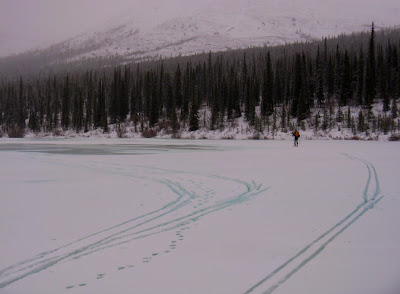
I think the Caribou Bluff cabin is one of my favorites. The petite log shelter radiates a very cozy and welcoming aura immediately when the front door is swung open. I can't quite place my finger on why the cabin conveys this feeling. Maybe it's because the simple layout is how I would have created such a place. The space is tight but very neatly and efficiently laid out. A narrow table is straddled on either side by two nicely sized bunk beds. This makes it possible to sit comfortably while eating a warm meal and then immediately roll over on to the softness of my down sleeping bag...and watch the northern lights dance across the night sky through the modest picture window.


Sunday, January 25, 2009
Caribou Bluff
Posted by
Ed Plumb
at
9:48 PM
1 comments
![]()
Wednesday, January 21, 2009
Ice Skiing Through the Mountains

Unbelievable... These were the only words I could mutter as we approached the Moose Creek cabin which rests on the edge of an open meadow in the White Mountains. It was just after midnight when we skied up the spur trail leading to the front porch. The temperature was 50 degrees above zero (+10 C). On this evening, portions of interior Alaska were experiencing the warmest January temperatures ever recorded since weather records began over 100 years ago.
I was dumbfounded. I just couldn't swallow the reality of this situation - that the atmosphere could possibly be so warm on a mid-January night just south of the Arctic Circle. But it was, so I struggled to embrace the unusual scene and tried to ignore the ramifications such warmth would have on the snowpack. Instead of the normal routine upon arrival at a cabin of firing up the wood stove and quickly shedding damp clothes, we propped open the door and windows and let the balmy southeast wind sweep through the log structure.











Hear the chatter of our skis in this video clip compiled by John:
Posted by
Ed Plumb
at
8:57 PM
4
comments
![]()
Labels: Ski Traverse
Friday, January 16, 2009
The COLD has snapped...
 Fairbanks is shrouded in a dense layer of ice fog during a bitter cold snap
Fairbanks is shrouded in a dense layer of ice fog during a bitter cold snap
Alaska is widely known as an icy mass of land positioned near the top of the globe. This is probably the general consensus among most people. The past few weeks have only reinforced this reputation. A bitter cold air mass which has been entrenched across this northern landscape rapidly departed to more southerly latitudes today. Temperatures around Fairbanks hovered between -30F(-34C) and -60F(-51C) for nearly two weeks. This was one of the longest cold stretches in the past few decades.
The icy grip was rapidly replaced by tropical air from the south. An unprecedented heat wave has shot temperatures up well above the freezing mark. Some locations experienced a rise of more than 100 degrees Fahrenheit in a matter of days. All-time record high January temperatures were broken at many locations. This is truly a land of extremes. Here is a graph showing the daily high (red) and low temperatures (blue) from late December to mid-January from a weather station near Fairbanks. The graph indicates that the temperature failed to get warmer than -40F (-40C) for about 10 days. There were also a few days when the mercury did not get warmer than -50F (-45C).
Here is a graph showing the daily high (red) and low temperatures (blue) from late December to mid-January from a weather station near Fairbanks. The graph indicates that the temperature failed to get warmer than -40F (-40C) for about 10 days. There were also a few days when the mercury did not get warmer than -50F (-45C). I have some more ice fog pictures from a previous post here: urban contrails
I have some more ice fog pictures from a previous post here: urban contrails
Posted by
Ed Plumb
at
11:28 AM
0
comments
![]()
Labels: Cold Weather


